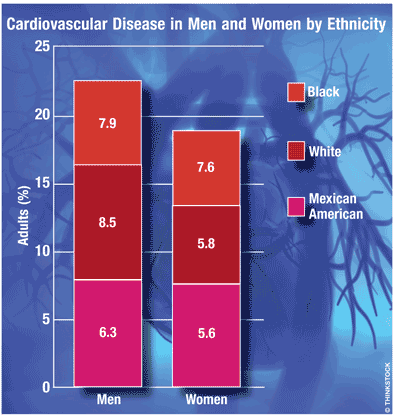US Pharm. 2013;38(2):6.
Hypertension, congestive heart failure, and coronary heart disease were the three most frequent cardiovascular diseases (CVDs) affecting the U.S. population (76.4 million, 16.3 million, and 16.3 million, respectively) in 2009. According to the 2012 National Institutes of Health report, 37.5% of the 1.3 million annual cases of heart attack were recurrent; stroke had a recurrence rate of 23.3%. CVD patients received the greatest number of days of hospital care (28.7 million).

Risk Factors and Death: According to a CDC report, high blood pressure, high LDL cholesterol, and smoking are key risk factors for heart disease, and 49% of adults have at least one of these three risk factors. Only one in three adults with high LDL cholesterol has the condition under control, and less than one-half of adults with high LDL cholesterol receive treatment. Chronic heart disease limited activity in 4.2 million adults. Heart disease was the leading cause of death in individuals aged 65 years and older; it was the second leading cause in those aged 45 to 64 years, and the third leading cause in those aged 25 to 44 years. High blood pressure was a primary or contributing cause of death in nearly 1,000 deaths per day. CVD was the most frequent cause of death (244.8 per 100,000 population) for all ethnic groups except Asian, Indian, and Hispanic females, in whom CVD was exceeded only by cancer as the cause of death.
Associated Costs: Of the total cost of care for all CVD patients ($297.7 billion), 60% ($179.3 billion) was for direct expenses. For hypertension, the direct expense was 93.7% of its total cost of care ($50.6 billion). However, in the case of both heart disease and stroke, there was an equal split between direct and indirect expenses. For all types of CVD, of the $33 billion spent on prescription drugs, 3.6% was for the treatment of stroke, 27.3% was for heart disease, and 64.5% was for hypertension. Of the $19.5 billion cost of providing home health care to all CVD patients, 39% was for heart disease, 30% was for stroke, and 26% was for hypertension. Of the $36.4 billion paid to office-based providers for care to CVD patients, 82.1% was for services for patients with heart disease (46.4%) and hypertension (35.7%). For CVD patients, emergency department and in-patient hospital costs constituted one-half of the total cost of care. For hypertension, a prescription drug ($21.3 billion) was the highest cost category, followed by the cost of outpatient care ($13 billion) and then emergency and inpatient care ($7.9 billion).
To comment on this article, contact rdavidson@uspharmacist.com.





